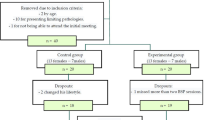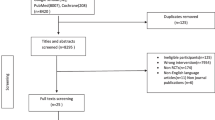Abstract
The purpose of this study was to investigate the long-term effectiveness of a spine care education programme conducted in 9- to 11-year-old schoolchildren. The study sample included 96 intervention subjects and 98 controls (9- to 11-year-olds at baseline). Intervention consisted of a 6-week school-based back education programme (predominantly biomechanically oriented) and was implemented by a physical therapist. Self-reported outcomes on back care knowledge, spinal care behaviour, self-efficacy towards favourable back care behaviour, prevalence of back and neck pain during the week and fear-avoidance beliefs were evaluated by the use of questionnaires. Post-tests were performed within 1 week after programme completion, after 1 year and after 8 years. Whereas the educational back care programme resulted in increased back care knowledge up to adulthood (P < 0.001), intervention did not change spinal care behaviour or self-efficacy. Pain prevalence figures increased less in the experimental group compared to the controls over the 8-year time span, yet statistical significance was not reached. Dropout analysis revealed spinal pain prevalence rates to be different in both groups throughout the study, including at baseline. Back education at young age did not reinforce fear-avoidance beliefs up to adulthood. Predominantly biomechanical oriented back education in elementary schoolchildren is effective in improving the cognitive aspect of back care up to adulthood, yet not in changing actual behaviour or self-efficacy. The current study does not provide evidence that educational back care programmes have any impact on spinal pain in adulthood. The true long-term impact of school-based spinal health interventions on clinically relevant outcome measures merits further attention.




Similar content being viewed by others
References
Watson KD, Papageorgiou AC, Jones GT et al (2002) Low back pain in schoolchildren: occurrence and characteristics. Pain 97:87–92
Jeffries L, Milanese SF, Grimmer-Somers KA (2007) Epidemiology of adolescent spinal pain—a systematic overview of the research literature. Spine 32:2630–2637
El-Metwally A, Mikkelsson M, Stahl M et al (2008) Genetic and environmental influences on non-specific low back pain in children: a twin study. Eur Spine J 17:502–508
Jones GT, Macfarlane GJ (2009) Predicting persistent low back pain in schoolchildren: a prospective cohort study. Arthritis Rheum 61:1359–1366
Clifford SN, Fritz JM (2003) Children and adolescents with low back pain: a descriptive study of physical examination and outcome measurement. J Orthop Sports Phys Ther 33:513–522
Zitting P, Rantakallio P, Vanharanta H (1998) Cumulative incidence of lumbar disc diseases leading to hospitalization up to the age of 28 years. Spine 23:2337–2343
Kjaer P, Leboeuf-Yde C, Sorensen JS et al (2005) An epidemiologic study of MRI and low back pain in 13-year-old children. Spine 30:798–806
Salminen JJ, Erkintalo MO, Pentti J et al (1999) Recurrent low back pain and early disc degeneration in the young. Spine 24:1316–1321
Rutges J, Creemers LB, Dhert W et al (2010) Variations in gene and protein expression in human nucleus pulposus in comparison with annulus fibrosus and cartilage cells: potential associations with aging and degeneration. Osteoarthritis Cartil 18:416–423
Balagué F, Nordin M, Dutoit G (1996) Primary prevention, education, and low back pain among school children. Bull Hosp Joint Dis 55:130–134
Cardon G, De Bourdeaudhuij I, de Clercq D (2002) Knowledge and perceptions about back education among elementary school students, teachers, and parents in Belgium. J School Health 72:100–106
Cardon GM, De Clercq DLR, de Bourdeaudhuij IMM (2002) Back education efficacy in elementary schoolchildren—a 1-year follow-up study. Spine 27:299–305
Cardon G, de Bourdeaudhuij I, de Clercq D (2001) Back care education in elementary school: a pilot study investigating the complementary role of the class teacher. Patient Educ Couns 45:219–226
Cardon GM, De Clercq DLR, Geldhof EJA et al (2007) Back education in elementary schoolchildren: the effects of adding a physical activity promotion program to a back care program. Eur Spine J 16:125–133
Chometon E, Braize C, Levy A (1999) A primary educational prevention program for low back pain in Saint-Etienne primary schools. Paris: Masson, 242–245
Feingold AJ, Jacobs K (2002) The effect of education on backpack wearing and posture in a middle school population. Work 18:287–294
Fernandes SMS, Casarotto RA, Joao SMA et al (2008) Effects of educational sessions on school backpack use among elementary school students. Rev Bras Fisioter 12:447–453
Geldhof E, Cardon G, De Bourdeaudhuij I et al (2007) Back posture education in elementary schoolchildren: stability of two-year intervention effects. Eura Medicophys 43:369–379
Geldhof E, Cardon G, de Bourdeaudhuij I et al (2007) Back posture education in elementary schoolchildren: a 2-year follow-up study. Eur Spine J 16:841–850
Goodgold SA (2003) Backpack intelligence: implementation of a backpack safety program with fifth grade students. Orthop Pract 15:15–20
Goodgold SA, Nielsen D (2003) Effectiveness of a school-based backpack health promotion program: backpack intelligence. Work 21:113–123
McCauley M (1990) The effect of body mechanics instruction on work performance among young workers. Am J Occup Ther 44:402–407
Mendez FJ, Gomez-Conesa A (2001) Postural hygiene program to prevent low back pain. Spine 26:1280–1286
Robertson H, Lee V (1990) Effects of back care lessons on sitting and lifting by primary students. Aust J Physiother 36:245–248
Rowe G, Jacobs K (2002) Efficacy of body mechanics education on posture while computing in middle school children. Work 18:295–303
Schwartz RK, Jacobs K (1992) Body basics, a cognitive approach to body mechanics training in elementary school back pain prevention programs. Work 2:53–60
Sheldon MR (1994) Lifting instruction to children in an elementary school. J Orthop Sports Phys Ther 19:105–110
Spence SM, Jensen GM, Shepard KF (1984) Comparison of methods of teaching children proper lifting techniques. Phys Ther 64:1055–1061
Storr-Paulsen A (2002) The body-consciousness in school—a back pain-school. Ugeskr Laeg 165:37–41
Burton AK, Balagué F, Cardon G (2006) Chapter 2—European guidelines for prevention in low back pain. Eur Spine J 15(Suppl2):S136–S168
Steele EJ, Dawson AP, Hiller JE (2006) School-based interventions for spinal pain—a systematic review. Spine 31:226–233
Cardon G, Balague F (2004) Low back pain prevention’s effects in schoolchildren. What is the evidence? Eur Spine J 13:663–679
Cherkin DC, Deyo RA, Street JH et al (1996) Pitfalls of patient education. Limited success of a program for back pain in primary care. Spine 21:345–355
Ajzen I (2005) Attitudes Personality, and Behavior. Open University Press, Milton-Keynes
Linton SJ, van Tulder MW (2001) Preventive interventions for back and neck pain problems: what is the evidence? Spine 26:778–787
Burton AK (1996) Low back pain in children and adolescents: to treat or not. Bull Hosp Joint Dis 55:127–129
Goubert L, Crombez G, De Bourdeaudhuij I (2004) Low back pain, disability and back pain myths in a community sample: prevalence and interrelationships. Eur J Pain 8:385–394
Linton SJ, Buer N, Vlaeyen J et al (2000) Are fear-avoidance beliefs related to the inception of an episode of back pain? A prospective study. Psychol Health 14:1051–1060
Egger G (1999) Health promotion strategies & methods. Sydney
Maddux J, Bradley L, Boykin A (1995) Self-efficacy and health behavior: prevention, promotion and detection. In: Maddux J (ed) Self-efficacy, adaptation, and adjustment: theory, research and application. Plenum Press, New York, pp 173–202
Acknowledgments
The authors are grateful to Elisa Everaert and Veerle Steeman for data collection, and to all the principals, teachers and participants for their cooperation in this study. No funds were received in support of this study. No benefits in any form have been or will be received from a commercial party related directly or indirectly to the subject of this manuscript.
Author information
Authors and Affiliations
Corresponding author
Additional information
The submitted manuscript does not contain information about medical device(s)/drug(s).
Rights and permissions
About this article
Cite this article
Dolphens, M., Cagnie, B., Danneels, L. et al. Long-term effectiveness of a back education programme in elementary schoolchildren: an 8-year follow-up study. Eur Spine J 20, 2134–2142 (2011). https://doi.org/10.1007/s00586-011-1856-9
Received:
Accepted:
Published:
Issue Date:
DOI: https://doi.org/10.1007/s00586-011-1856-9




